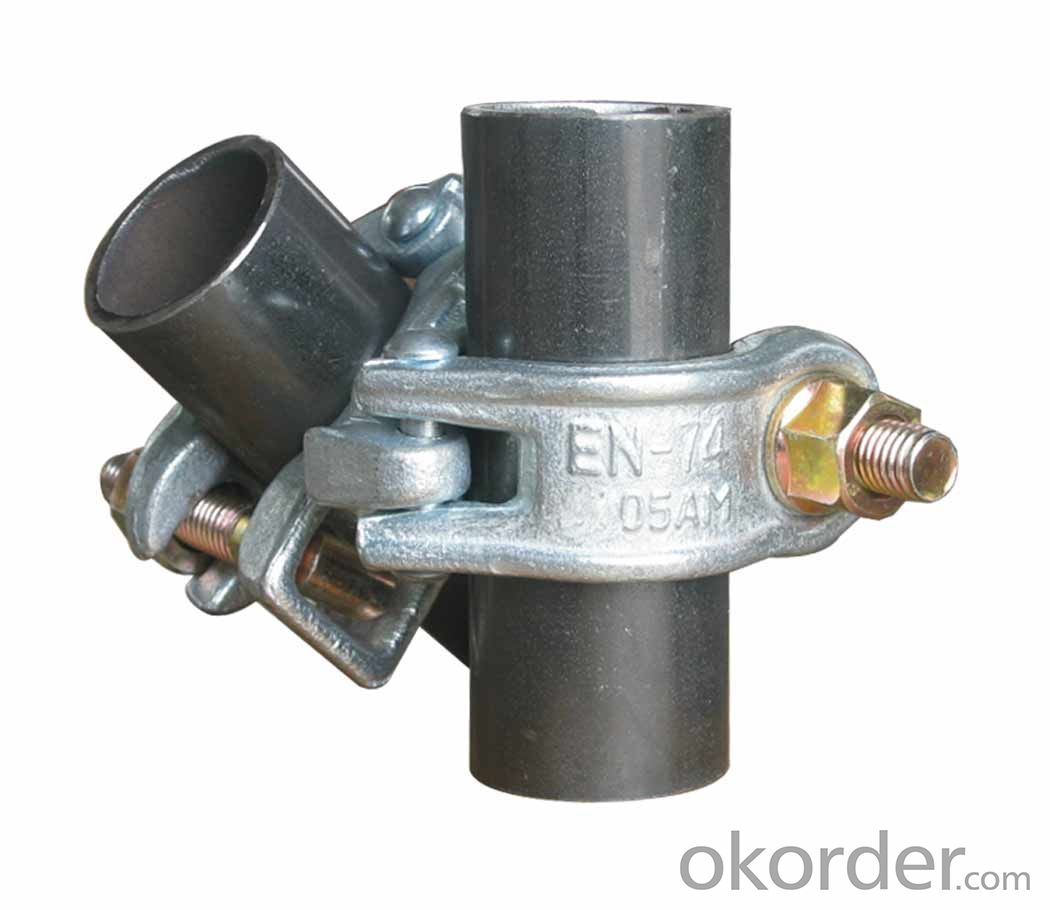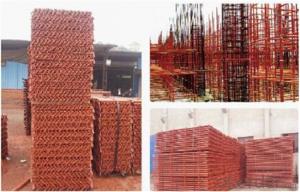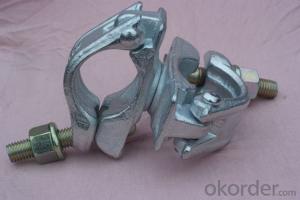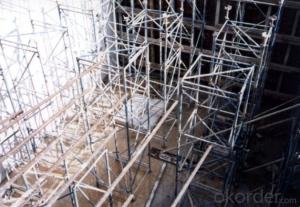Scaffolding Swivel Clamp british German Forged Type
- Loading Port:
- Tianjin
- Payment Terms:
- TT OR LC
- Min Order Qty:
- 1000 kg
- Supply Capability:
- 100000 kg/month
OKorder Service Pledge
OKorder Financial Service
You Might Also Like
Scaffolding Swivel Clamp british German Forged Type
Description
1.The scaffolding coupler is always used to connect the steel pipe as scaffolding system.
2.The often used coupler is swivel coupler and righ angle coupler .
3.We can provide types of scaffolding coupler according to your requirement.
4.Couoler can fix the 48.3mm scaffolding steel pipe tightly and make the whole scaffolding system more steadily.
Feature
(1)Excellent Anti-Breaking—Cold Pressed Steel
(2)Outstanding Resistance Deformation
(3)Strong Anti-Dropping Ability
Photo

Parameter
| Material | Q235,345steel |
| Size | 48.3mm*48.3mm |
| Surface finish | Galvanized |
| Weight | 1.1kg around |
| Standard | BS1139,EN74 |
| Package | 25pcs/bag,steel pallet |
| Manufacture | As per customer requirement |
| Market | Africa, South America, the Middle East and Asia |
FAQ
Q: Are you a factory or trading company?
We are a state-owned corporation in China,dealing with various kinds of building materials.We have our holding subsidiaries.
Q: Where is your factory located? How can I visit there?
Our factory is located all around China.
Q: Can I get some samples?
Sample is free, customer only pay freight for the first time.
Q: Delivery?
10-30days. (5-15 containers)
Any question,feel free to contact us.
- Q: What are the typical dimensions and weight of a steel tube coupler?
- The dimensions and weight of a steel tube coupler can differ based on its specific type and application. Nevertheless, there are typical dimensions and weight ranges that are worth considering. In general, a steel tube coupler is crafted to connect two steel tubes together, ensuring a secure and robust connection. The dimensions usually encompass the outer diameter and length of the coupler, which are vital for compatibility with the connected tubes. Ordinarily, the outer diameter of a steel tube coupler varies from 1 inch to 4 inches (2.54 cm to 10.16 cm). Additionally, the length of the coupler can fluctuate, ranging from 2 inches to 8 inches (5.08 cm to 20.32 cm). These dimensions are commonly utilized in a range of industries, including construction, scaffolding, and engineering. Concerning weight, it relies on the size and material of the coupler. A smaller coupler with a 1-inch diameter (2.54 cm) and 2-inch length (5.08 cm) may weigh approximately 0.1 pounds (0.045 kg), while a larger coupler with a 4-inch diameter (10.16 cm) and 8-inch length (20.32 cm) can weigh up to 2 pounds (0.91 kg) or more. It is crucial to note that these dimensions and weight ranges are not fixed and can vary based on the manufacturer and specific design requirements. Therefore, it is always advisable to consult the product specifications provided by the manufacturer or supplier for precise information regarding the dimensions and weight of a steel tube coupler.
- Q: Are there any specific guidelines for the safe dismantling of scaffolding structures with steel tube couplers?
- Yes, there are specific guidelines for the safe dismantling of scaffolding structures with steel tube couplers. These guidelines typically include proper planning and risk assessment before starting the dismantling process, ensuring the stability of the scaffold during dismantling, using appropriate tools and equipment for disassembly, following a systematic and controlled dismantling sequence, and ensuring the safety of workers involved by providing adequate training and supervision.
- Q: Can steel tube couplers be used in scaffolding structures with specialized requirements, such as protection against seismic activity?
- Yes, steel tube couplers can be used in scaffolding structures with specialized requirements, including protection against seismic activity. Steel tube couplers are known for their strength and durability, making them suitable for withstanding seismic forces. Additionally, their flexibility allows for easy assembly and disassembly, making them a practical choice for scaffolding structures in areas prone to seismic activity.
- Q: "Construction of fastener type steel pipe scaffold safety technical specifications" in the page 69 Table c-4 "minimum number 4" how to understand
- The Rongsheng BCD-232M Basic parameters Product category Three open the door Total volume 232L Freezer compartment volume 133L Freezer compartment volume 41L Temperature change volume 58L Rated power consumption 067 Insulation material VIP vacuum insulation board technology Refrigeration cycle system Double cycle temperature control mode Computer temperature control compression Machine Free Fluorocarbon High Efficiency Compressor Display Touch Screen Shelf Type Tempered Glass Shelf Door Seal Removable Airbag Style Door Seal Outline Design Blue, Red, Silver Dimensions 555 * 613 * 1797mm * Hydrogen Free Fluoride Foam.
- Q: What are the safety precautions to consider when using steel tube couplers in scaffolding?
- When using steel tube couplers in scaffolding, there are several safety precautions to consider. Firstly, it is important to ensure that the couplers are properly inspected and maintained before use to check for any signs of damage or wear. Additionally, the couplers should be securely tightened and locked in place to prevent any movement or disconnection during use. It is crucial to follow the manufacturer's guidelines and weight limits for the couplers to avoid overloading or structural failure. Workers should always wear appropriate personal protective equipment, such as helmets and safety harnesses, when working on or around scaffolding with steel tube couplers. Finally, regular inspections and monitoring of the scaffolding system should be conducted to identify any potential hazards or issues that may arise.
- Q: Can steel tube couplers be used for both residential and commercial scaffolding applications?
- Yes, steel tube couplers can be used for both residential and commercial scaffolding applications. Steel tube couplers are versatile and strong connectors that are commonly used in the construction industry to join scaffolding tubes together. They provide a secure and reliable connection, ensuring the stability and safety of the scaffolding structure. Whether it is for a residential project like home renovations or a larger commercial construction site, steel tube couplers can be used effectively in various scaffolding applications. They are designed to withstand heavy loads and provide a durable connection, making them suitable for both residential and commercial scaffolding needs.
- Q: External scaffolding for the two-pole scaffolding erect height of 26m, how to prepare this scaffolding program ah, this scaffolding can take so high?
- You can Google Oriental Rainbow's official website, there are rainbow days cat flagship store and other links will have the price and product display, you can also contact Rainbow customer service, it is recommended that you choose the East Rainbow waterproof products and standardized construction team, the East Rain rainbow is the best quality waterproof listed companies RPUF-372 sprayed hard foam polyurethane external wall insulation (thin plaster - paint finishes) system "rain rainbow" spray hard foam polyurethane external insulation (thin plaster - paint Surface) system by spraying hard foam polyurethane insulation layer and wall self-bonding, and on it to do the polymer leveling mortar layer, thin plaster layer full of alkali-resistant mesh cloth reinforced, polymer surface mortar, Flexible putty and external wall elastic paint composition
- Q: Can steel tube couplers be used in temporary structures for events or concerts?
- Yes, steel tube couplers can be used in temporary structures for events or concerts. Steel tube couplers are commonly used in construction and scaffolding industries to connect and secure steel tubes together. They provide a strong and durable connection, ensuring the stability and integrity of the structure. For temporary structures at events or concerts, steel tube couplers can be used to create frameworks for stages, tents, grandstands, or other structures that require a temporary solution. These couplers allow for quick and easy assembly and disassembly, making them ideal for temporary setups. Additionally, steel tube couplers are versatile and can be used in a variety of configurations to meet specific design requirements. They are available in different sizes and types, such as swivel couplers, sleeve couplers, or right-angle couplers, allowing for flexibility in creating custom structures. Furthermore, steel tube couplers are known for their high load-bearing capacity and resistance to external forces, making them suitable for use in temporary structures that may be subject to heavy loads or dynamic forces during events or concerts. Overall, steel tube couplers are a reliable and efficient choice for temporary structures in the event or concert industry, providing a secure and stable connection that ensures the safety of the structure and its occupants.
- Q: How do steel tube couplers contribute to the overall efficiency of a scaffolding project?
- Steel tube couplers contribute to the overall efficiency of a scaffolding project in several ways. Firstly, they provide a secure and reliable connection between the scaffold tubes, ensuring that the structure is stable and safe for workers. This reduces the risk of accidents and improves productivity as workers can focus on their tasks without worrying about the stability of the scaffold. Secondly, steel tube couplers are quick and easy to install, allowing for faster assembly and disassembly of the scaffolding. This saves valuable time on the construction site and increases efficiency by enabling workers to complete their tasks more efficiently. Additionally, steel tube couplers provide flexibility in scaffold design, allowing for various configurations and adjustments. This adaptability is crucial in complex projects where the scaffold needs to be modified to fit different spaces and heights. The ability to make changes easily and quickly improves efficiency by reducing downtime and increasing the overall productivity of the project. Furthermore, steel tube couplers are durable and long-lasting, ensuring the stability of the scaffold throughout the project's lifespan. This eliminates the need for frequent repairs or replacements, saving both time and money. Overall, steel tube couplers play a vital role in the overall efficiency of a scaffolding project by providing a secure connection, enabling quick installation and adjustments, and ensuring the durability of the scaffold. Their contribution enhances worker safety, saves time, and improves productivity, making them an essential component in any scaffolding project.
- Q: Are there any specific certifications or qualifications required for installing steel tube couplers in scaffolding?
- Yes, specific certifications or qualifications are required for installing steel tube couplers in scaffolding. In many countries, scaffolding installation is regulated by local authorities or industry organizations, and individuals are required to obtain relevant certifications or qualifications to ensure safety and compliance with industry standards. These certifications or qualifications typically involve training and assessments to demonstrate the knowledge and skills necessary for proper installation and use of steel tube couplers in scaffolding.
Send your message to us
Scaffolding Swivel Clamp british German Forged Type
- Loading Port:
- Tianjin
- Payment Terms:
- TT OR LC
- Min Order Qty:
- 1000 kg
- Supply Capability:
- 100000 kg/month
OKorder Service Pledge
OKorder Financial Service
Similar products
Hot products
Hot Searches
Related keywords




























